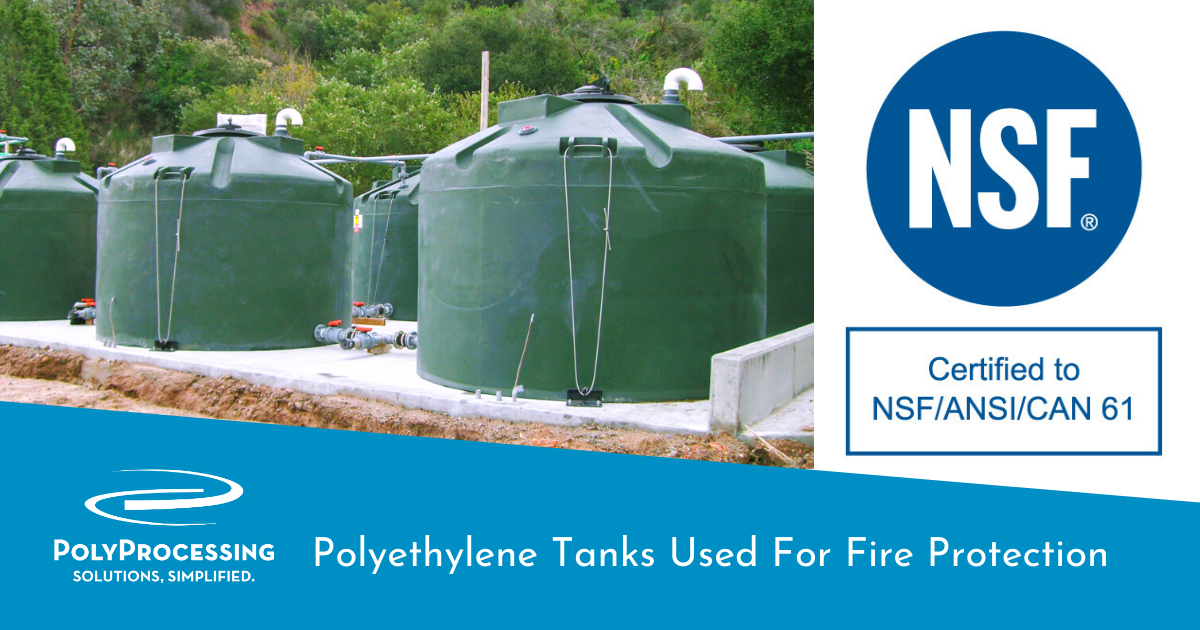Polyethylene Tanks Used For Fire Protection
Safe water storage is important for both residential and commercial uses. In residential applications, homeowners capture rainwater for watering lawns and gardens. Water storage is necessary in a wide variety of commercial processes, including farming irrigation, livestock care, and cleaning.

However, fire protection water systems are often vital for both commercial and residential applications.
Polyethylene Versus Other Tank Materials
Water storage tanks are available in a variety of materials, including galvanized or stainless steel (either bolted or welded), polyethylene, wood, or concrete.
Polyethylene has several advantages over the alternatives:
- Unlike galvanized steel, polyethylene tanks won’t corrode or rust.
- PPC Poly tanks are a cost effective alternative to stainless steel.
- Unlike galvanized or stainless steel, polyethylene tanks are manufactured with a seamless construction that eliminates rivet or weld points — areas that are subject to leaks.
- Polyethylene tanks are available in color variations like green or black to prevent algae growth due to exposure to light.
- Polyethylene tanks are lightweight. This allows for easy transportation and installation flexibility.
- Polyethylene tanks can easily accommodate a wide range of fittings and accessories based upon your specific needs.
Why Choose a Higher Quality Water Storage Tank

While price is a driving factor for many water tank buyers, quality and flexibility provide a long-term superior value. All Poly Processing water storage tanks meet ASTM standards. This ensures that our poly tanks meet the required wall-thickness to store its contents.
Many water storage tanks are built using a much thinner plastic. In contrast, our water storage poly tanks are designed to have thicker walls and last longer.
Poly Processing water storage tanks can also meet NSF 61 standards for potable water.
Critical Fire Protection in Rural Areas
While strict interpretation of NFPA 22 Section 4.4.1 does not authorize the use of polyethylene water tanks, many jurisdictions permit the use of plastic tanks because the alternatives are cost prohibitive. Many private rural/farm systems use tank-stored water from local wells for fire protection as well as domestic water supply.
The connection to a water tank for residential fire protection is called a drafting connection. This is the most important part of the system because the fire department needs to be able to connect to your water source — in this case, your Poly Processing tank — to its pumper truck in order to use it. The connection typically consists of a four-inch pipe system from the tank with a shutoff valve and a suitable connection for the local fire department.
Contact your local permitting authority to get the proper specifications for the drafting connection.
Water Storage Tanks to Your Specifications
In addition to superior quality, Poly Processing offers flexible options for tank fittings and accessories. You can specify the location of inlets, outlets, and add accessories such as float indicators and we'll build a water storage tank that meets your specific requirements.
In terms of tank color, standard natural tanks are available, along with black and green options. Tank sizes are available in a wide range-from 55 to 10,300 gallon capacity. Download our latest Product Catalog to view all of our tank system options.
Contact a Poly Processing tank specialist with any questions or to build a water storage tank that meets your needs.
- April 26, 2021
- Topics: Applications
About Poly Processing
Posts By Topic
Tech Talk Podcast Episodes
Subscribe By Email
Recent Posts
- Maximizing Fill Efficiency: Selecting the Optimal Fill Line System
- Chemical Storage Tanks: A Quick Guide for End Users
- Popular Customization Options for Chemical Storage Tanks
- Understanding Flood Zones Under the IBC: Building Requirements and Insurance Implications
- Choosing Between Steel, Polyethylene, and Fiberglass Tanks: What You Need to Know
Tank Configurator

Find the recommended tank and system components for your chemical storage challenge.
Configure a Tank Package



